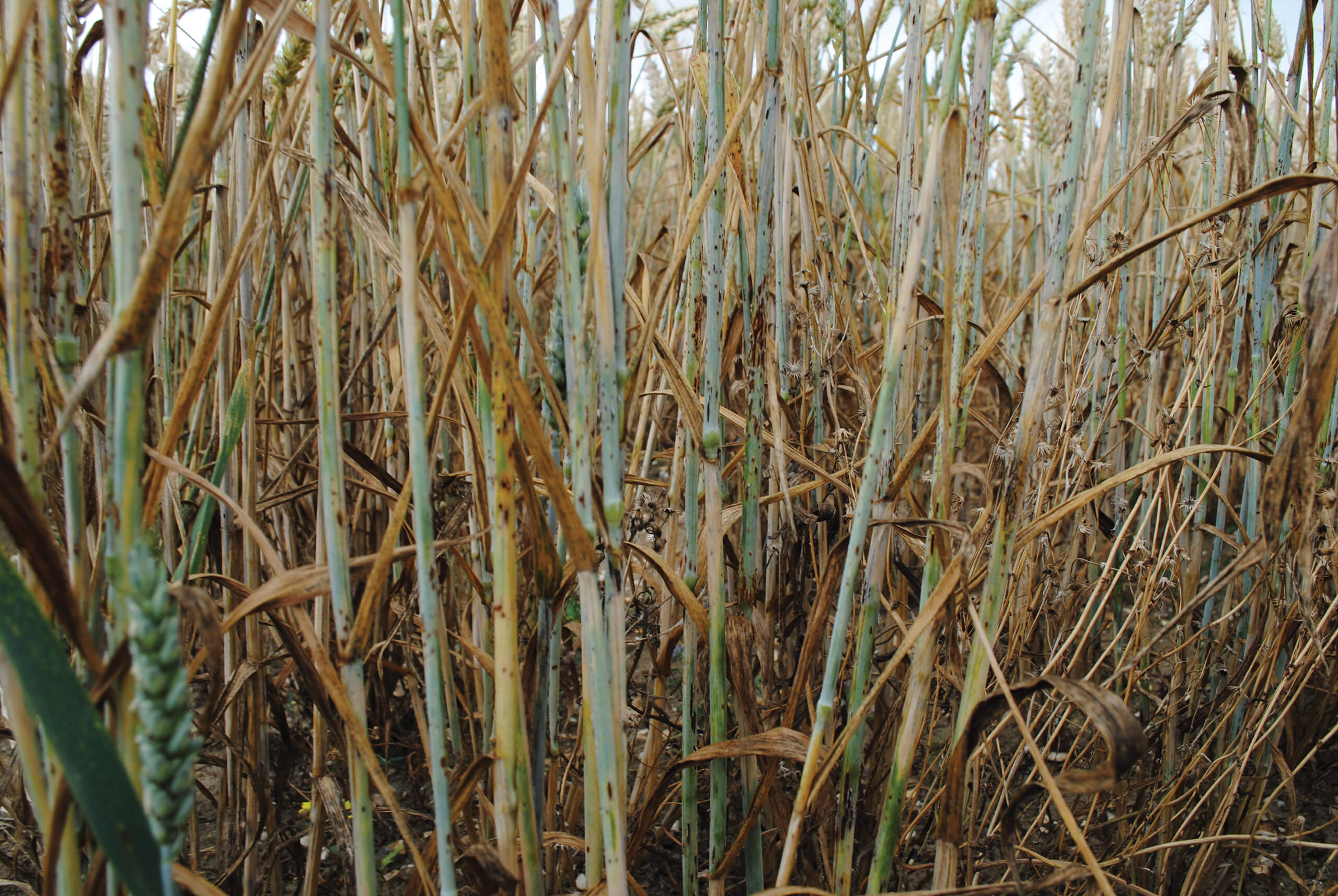
Since man began raising crops, pathogens have seized every opportunity to get ahead. Researchers believe “convergence science” is now essential to give humans the edge and prevent plant pandemics.
Disease pandemics have shaped the history of the world many times. In 1845, late blight led to the Irish Potato Famine, causing the mass migration of over two million people as they fled the Emerald Isle to avoid starvation.
In 1943, rice crops succumbed to brown spot, causing the Bengal famine, and as recently as the 1990s, cassava mosaic virus caused a severe famine in Uganda. Plant diseases continue to emerge and re-emerge to threaten crop production.
In the Southern Hemisphere, wheat blast is the newest cereal disease to trouble crops. First found in Brazil in 1985, it spread quickly through South America, infecting around 7.5 million acres of wheat within a decade. In 2016, wheat blast appeared in Bangladesh and then skipped to the African continent, where it was discovered in 2020 infecting wheat crops in Zambia.
Wheat rust diseases have global significance, causing crop losses of $3 billion each year. Of these, black stem rust is of particular consequence, and concerningly, it’s a disease re-emerging in Europe after not being seen for many decades.
Source: S. Savory et al, “The global burden of pathogens and pests on global food crops”. Nat. Ecol. Evol (2019)
Despite advances in fungicide technology and plant breeding, global losses due to diseases in food crops are considerable and estimated by the Food and Agriculture Organization to cost over $220 billion annually.
According to the UN body, a quarter of the global population is currently experiencing food insecurity. With the number of humans on the planet expected to reach 10 billion by 2050, the world simply can’t afford to lose the race against plant diseases.
With increasingly volatile weather conditions likely to fuel the spread of plant diseases to new regions and anthropogenic factors facilitating disease movement across borders and oceans, how can humanity stay ahead of the risks potential pandemics pose?
A group of researchers led by Professor Jean Ristaino, a plant pathologist at North Carolina State University, recently published a paper in Proceedings of the National Academy of Sciences stressing the need for integration across scientific disciplines and the globe to predict and mitigate potential plant pandemics.
“The idea is to detect plant disease outbreaks early and stop their spread before an outbreak becomes a pandemic,” she says. “Once underway, a pandemic is difficult to control.”
Related article

New remedies for ancient problems
Fungal infections have dogged agriculture for millennia, but new fungicides – though the process...
First line defenses
Just as with human pandemics, disease surveillance forms a first line of defense, supported by improved disease detection systems and predictive disease modeling. While some diseases are already under some sort of global surveillance – for example, wheat rust and late blight – other diseases aren’t routinely monitored.
Rather than leaving farmers to fend for themselves on the front line, Ristaino calls for a wide range of scholars to join forces – so-called convergence science – to prevent plant pandemics.
Professor Diane Saunders agrees time is of the essence when it comes to detecting outbreaks, and particularly for the rust diseases that are her research focus at John Innes Centre (JIC).
“Diseases such as stem rust are very successful and have been around since the dawn of agriculture. The pathogen always wants to win, so we need to be able to rapidly respond – detect the causal agent quickly and react fast by treating the disease before it spreads and, where possible, shift to varieties resistant to current pathogen strains.
“If diseases are unusual or unexpected, it can be diffi cult for farmers and agronomists to identify them in the field. This is an issue with wheat blast, for instance, which looks very similar to the symptoms of fusarium head blight – white ears on otherwise green plants.”

Ristaino’s North Carolina University team is developing rapid in-field diagnostics linked with smartphones to quickly identify late blight and other Phytophthora diseases.
The field of rapid diagnostics is evolving fast. “As with COVID, lateral flow tests have been developed for wheat blast and some other diseases, which is exceptionally valuable where the cause is unclear from the symptoms alone. Yet for many diseases, knowing the precise strain of the pathogen is critical to establish fungicide management or which crop varieties are under threat,” says Saunders.
Potato blight is a case in point, with many countries sending samples to a central testing lab for time-consuming strain identification. However, Ristaino’s North Carolina University team is developing rapid in-field diagnostics linked with smartphones to quickly identify late blight and other Phytophthora diseases.
Researchers at JIC have come up with a rapid field test for genotyping yellow and stem rust, which is being used in Africa and South Asia to help farmers respond more rapidly to disease outbreaks.
Forecasting is another vital tool and can help predict where a disease may next emerge. Demonstrating convergence science, a team of scientists at the University of Cambridge, the UK Met Office, and the International Maize and Wheat Improvement Center (CIMMYT), have adapted modeling systems – previously used to forecast ash dispersal from erupting volcanoes and radiation from nuclear accidents – to predict when and how strains of stem rust are most likely to spread.

Stem rust has also recently reappeared in several European countries where varietal resistance is practically non-existent.
Stem rust
Stem rust poses a significant threat to wheat harvests, capable of spreading across continents and decimating the wheat crops in its path. In the 1950s, the disease was stopped in its tracks when Nobel Peace Prize laureate Norman Borlaug developed wheat varieties that could resist the fungal attack.
However, in 1998 a new race of stem rust, Ug99, started to spread rapidly across Africa and South Asia. It overcame existing defenses in wheat varieties and led to devastating crop losses before new resistant varieties became available.
Meanwhile, further evolutions of the pathogen have seen the disease become more virulent and infect varieties with resistance to Ug99. Stem rust has also recently reappeared in several European countries where varietal resistance is practically non-existent, giving rise to fears it could be a ticking time bomb.
The results of advanced modeling highlight Yemen as a potential stepping-stone for the transmission of the disease between continents. “New races of wheat rust are threatening wheat worldwide and we need to know which areas are at risk,” says Professor Chris Gilligan of Cambridge University’s Department of Plant Sciences.
“We now believe that if we start to see Ug99 or other new wheat rust strains take hold in Yemen in early spring, action must be taken immediately to mitigate the risk of further spread.” The team says their work, including 3D spore dispersal animations and a catalog of dispersal trends (indicating likely directions, frequencies, and pathogen loads), provides new ways to raise awareness, communicate risks, and inform agricultural stakeholders.
Saunders believes including advanced diagnostics alongside such modeling predictions is like putting together pieces of a puzzle – it reveals the big picture. An early warning system for yellow and stem rust has been developed for use in Ethiopia, East Africa’s largest wheat-producing country, to help wheat growers apply fungicides effectively.
Projects such as this epitomize convergence science – integrating field and mobile phone surveillance data, spore dispersal and disease environmental suitability forecasting, as well as communication to policymakers, advisors, and smallholder farmers.

Atmospheric factors
The changing weather adds another level of uncertainty when it comes to the potential for plant disease to affect global food security. Dr. Helen Fones, Plant Pathologist at the University of Exeter, says the climate determines whether a plant is stressed or healthy, which in turn affects disease resistance.
Even more difficult to predict are the complex interactions between weather, human behavior, and non-climate environmental factors such as air pollution.
“Just as sulfur gases affected wheat pathogens in the 1970s, atmospheric concentrations of other gases – such as ozone and nitrous oxides – also alter plant defenses and pathogen performance.”
Ristaino expects that more volatile weather conditions will likely exacerbate disease outbreaks. For example, drought in Saharan Africa affects the population and range of locusts that devastate crops further south in sub-Saharan Africa. Climate data can also help develop models to forecast diseases and their spread.
“More frequent rainfall allows airborne plant pathogens to spread and fungal spores can move with hurricanes, which is how soybean rust came to North America from South America– via storms,” adds Ristaino.
Furthermore, the global nature of the food trade is driving some plant disease pandemics, as has been seen with wheat blast.
Meanwhile, research institutes are working hard to find genetic solutions. In the Saunders lab, research is ongoing to look at gene cloning and using gene editing to disrupt susceptibility genes – effectively removing something from the plant that a pathogen needs to survive.
“We know gene disruption works in the greenhouse and within the next five years this will be tested in the field, and beyond that, hopefully introduced into commercial varieties,” Saunders concludes.
Wheat blast: new resistance gene discovered
Wheat blast is essentially a new disease and can cause 100% yield loss if infection occurs before or during anthesis. It’s widely considered a threat to food security in developing countries and capable of disrupting the economic wellbeing of developed nations. So where did the wheat blast fungus come from?

Professor Paul Nicholson, group leader of the Delivering Sustainable Wheat program at the John Innes Centre, explains there are two lines of thought within the scientific community. “The initial theory is that wheat varieties in Brazil lacked a resistance gene Rwt3, and this allowed the fungus to ‘jump’ from wild grass. Subsequently, there’s been evolution and new variants have appeared through sexual recombination,” he explains.
Professor Mark Farman at the University of Kentucky has an alternative theory that runs counter to the story of slow evolutionary change, says Nicholson. In a paper published in 2023, Farman concludes the wheat blast pathogen is highly host-specific, casting doubt that it evolved from grasses.
Instead, his data indicates a relative of the wheat blast fungus was imported to Brazil from Africa in grass seed. It subsequently crossed with native grass-infecting species and this led to the recombination of the entire spectrum of virulence factors – a ‘big bang’ event producing a hybrid swarm and pathotypes capable of infecting wheat.
“It wasn’t a huge concern until wheat blast appeared in Bangladesh and this was a clonal lineage that had come from South America, most likely in seed intended for human consumption that was planted instead. Man has been involved in every stage of this wheat blast’s progression,” says Nicholson.
Nicholson explains there is one resistance gene known to confer blast resistance and it came serendipitously from a French wheat line developed to control eyespot. “This line contained a small segment of a chromosome (termed 2NS) from a wild grass (Aegilops ventricosa). The 2NS segment has since been found to carry resistance to nematodes and other diseases, including wheat blast – although it varies in its effectiveness depending on the genetic background of the variety.”
The race is on to find other resistance sources. The team at JIC has recently discovered a gene previously reported to confer powdery mildew resistance, Pm4, which can easily be combined with 2NS and should help in the fight against the ‘Bangladesh’ strain of the disease.
“Pm4 doesn’t appear to be present in CIMMYT germplasm since selection for powdery mildew resistance isn’t a major target for many breeders. There are different versions of Pm4, and they don’t all function equally well in wheat leaves and spikes.
“We’re working to help introduce the versions that are most effective and confer resistance in both the seedlings and spikes to provide ‘all-round’ resistance.”
The search continues to find additional resistance genes to target the diverse wheat blast population in South America and try and help breeders stay more than one step ahead of changes in the pathogen populations.
Plants that monitor themselves
Imagine being able to download a report communicated by the crop itself, detailing whether pathogens are infecting, whether it’s suffering drought stress, as well as its photosynthesis and hormone levels.
It may be a few years before in vivo sensing
appears in the field but scientists are working to develop real-time, continuous health monitoring in plants.
Possible approaches are:
- Synthetic biology: genetic engineering to create “phytosensors” – plants transformed with synthetic promoters fused to reporter genes that indicate plant abiotic and biotic stresses
- Imaging and spectroscopy techniques like thermography, fluorescence, Raman spectroscopy, and X-ray spectroscopy to detect plant stresses non-invasively
- Electrical sensors integrated into plants, like ‘wearable’ sensors or organic electrochemical transistors, to measure
plant physiology
2024
New wheat blast resistance gene introduced into
CIMMYT wheat breeding lines as the search continues for genes resistant to blast and stem rust.
Next
Gene-edited lines containing susceptibility disruption genes are likely to be tested in the field. Modeling and disease diagnostics improve through convergence science.
Beyond
Research institutes continue the search to shore up resistance to evolving pathogens. Faster breeding enables quicker introduction of new resistant commercial varieties.
Plants monitor themselves using in vivo sensing.




